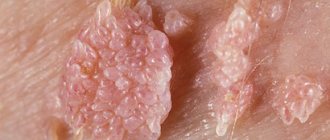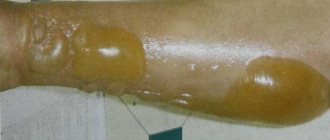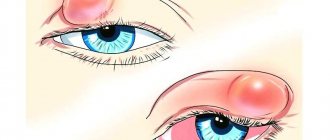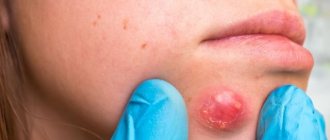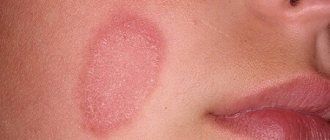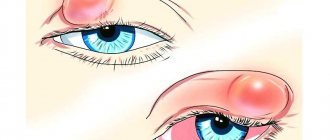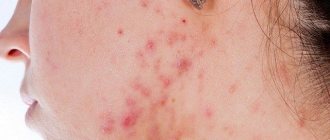- Viral skin diseases: causes, classification
- Herpes
- Shingles (herpes zoster)
| |
Vulgar or simple (ordinary) warts are caused by the human papillomavirus-2 (HSV-2), which selectively affects the epidermis. Vulgar warts on the hands make up 70% of all warts and are localized benign hyperplasia of the epidermis.
Infection with warts occurs through contact—by contact with the affected skin. The penetration of the virus is facilitated by minor injuries, leading to disruption of the integrity of the stratum corneum of the epidermis, dry skin, acrocyanosis, hyperhidrosis, and a decrease in the pH of the water-lipid mantle.
Routes of infection with human papillomavirus, which causes the development of warts
The virus can reach a healthy person through direct contact - a handshake, for example, or through infected objects: toys, handrails on public transport. Two to three hours of virus life in the external environment is enough for someone to become infected with warts: the infection is quite common.
Cosmetic defect is the main complaint of patients with warts. There is usually no pain. Moreover, many medical procedures, such as cryodestruction, cause more suffering than the warts themselves.
Clinical picture of warts
Externally, warts are dense nodules with a diameter of 1 to 10 mm (sometimes more), round or polycyclic in shape. Their surface is covered with cracks, horny layers, and vegetations. The color of warts often does not differ from the healthy skin surrounding them, but under a magnifying glass you can see black-brown dots, which are capillaries filled with blood clots.
The rash can be represented by either one element or multiple, randomly located isolated nodules. After a wart is removed, new ones (daughter ones) may appear around it, arranged in a circle. Warts are localized in easily injured areas: hands, fingers, knees. Localization of warts on the fingers and palms leads to changes in the skin pattern. In this situation, the recovery of fingerprints is a sign of recovery.
There are several types of warts.
Common warts
Dense, dry, limited, painless keratinized elevations with an uneven villous surface, the size of a pinhead to a pea. They can merge to form large plaques. Most often located on the hands.
Plantar warts
They are a type of common warts - they appear in places where shoe pressure is applied, especially in those who sweat a lot. Very dense, keratinized, gray-dirty plantar warts are characterized by severe pain that prevents walking; sometimes cause temporary disability.
Flat or juvenile warts
They usually occur in children and young people. They look like round or irregularly shaped flat nodules that are located on the back of the hands, as well as on the skin of the face. The appearance of flat warts is promoted by skin irritation (they often occur along the course of scratches, cuts, etc.).
What warts can lead to cancer? Let's discuss it with a dermatologist
Not long ago we wrote a detailed article about the types of warts and methods of treating them, you can read this link. In today’s article, we will look at the myths about warts and ask dermatovenerologist Oleg Vladimirovich Demchenko from the Moscow MC “Health” about which of them can still lead to cancer.
— Oleg Vladimirovich, is it true that warts are a precancer?
No, this is not true, and such a question has never faced doctors. Such information is distributed on the Internet without going into detail, often in order to sell a person some kind of miraculous ointment. In fact, we know that warts, or papillomas, are caused by different strains of human papillomaviruses - some of them have a high oncogenic risk, others have almost zero.
— That is, if a person has HPV, then he is at risk?
More than half of the world's population is infected with HPV. Some people live their whole lives without even noticing it, because the immune system suppresses the virus. But if immunity decreases, a person develops those same notorious warts in different parts of the body. If you have them, it makes sense to consult a doctor and get tested for HPV strains. There are a number of the most dangerous strains - 16, 18, 30, 31, 33, 39, 40, 42, 43, 52, 55, 57-59, 61, 62 and 67-70. They have an extremely high oncogenic risk. For example, 90% of malignant tumors of the oropharynx, cervix and anal canal are caused by strains 16 and 18.
— Does it happen that the strain is low-oncogenic, but a tumor has formed that is malignant?
This happens, but very rarely. In any case, a wart is a reason to make an appointment with a doctor and get checked.
— Are there
any types of warts that still indicate oncology?
Even if indirectly. Yes, these are papillomas in the nasopharynx, mammary glands, genitals and anal canal. You can’t delay with such warts. It is necessary to undergo an examination as soon as possible, eliminate the risk of malignancy and remove the resulting papillomas.
— Maybe it’s easier to buy
some ointment and cure it at home?
This is the first time I’ve heard that ointments reduce the risk of cancer. But medicine knows about the development of chemically induced tumors as a result of the use of all kinds of dubious sprays, ointments and creams. It's not worth the risk.
- They say warts can go away on their own...
This actually happens if an HPV outbreak was simply triggered by a decrease in a person’s immunity. Warts on the hands and feet sometimes disappear as a result of improved immunity and hygiene. This happens often in children, for example. The body returns to stable functioning, strong immunity suppresses the virus. But this cannot be predicted. If you have papillomas, you cannot be sure whether they will disappear over time or will begin to spread and grow at a rapid rate. In our country, people don’t like to go to the hospital; they wait for it to go away on its own, so we, doctors, sometimes encounter advanced cases. Patients come when papillomas prevent them from walking (in the case of growth on the feet) or living a full sexual life (in the case of developing genital warts on the genitals).
— Can you recommend
any preventative measures?
First of all, a healthy lifestyle and maintaining immunity in all seasons. Taking care of body hygiene, contraception during sexual intercourse. And, of course, timely consultation with a doctor in case of papillomas. We need to overcome our fear of hospitals and doctors. Health should come first!
Not every wart will turn into cancer, so you shouldn’t believe loud headlines and buy dubious drugs and ointments on the Internet. Recently, cancerophobia has been developing in the world - the fear of developing cancer. People begin to see cancer in any symptom, which leads to the development of neuroses rather than to oncology.
Listen to the advice of doctors, undergo a full annual examination to exclude the development of chronic diseases, including oncology. In the network of Moscow MCs “Health”, doctors are ready to see you - therapists, gynecologists, urologists, surgeons, physiotherapists, cardiologists, dentists and other specialists. You can take tests and undergo a full examination if symptoms that concern you arise.
Be healthy!
Basic methods for removing warts
The two most commonly used methods for removing warts are cryotherapy and removal using a radio wave scalpel. If cryotherapy is performed, warts that appear on the patient's skin are treated with liquid nitrogen, a substance that allows objects to be cooled to very low temperatures. Namely, up to -187 degrees. After such a strong freezing of the wart, a characteristic bubble forms in its place after some time. Soon it opens, a wound forms in its place, which heals within 2-3 weeks, then a scar forms in this place. This method of removing warts is almost painless (there is only mild discomfort). The disadvantage of this method is that it is difficult to control the depth of removal, and therefore the remaining scar may be quite large or the wart may not be completely removed.
Removal using a “radio wave scalpel” involves exposing the wart to radio wave energy. This method is effective and safe. It allows you to accurately control the depth and size of the impact.
Removing warts using radio waves
1. A 1-2% solution of local anesthetic (for example, lidocaine) is injected into the area around the wart or under it.
2. Using a radio wave scalpel, the wart is excised within healthy skin.
Immediately after removal, a fairly deep wound is formed at the site of the wart (to the entire depth of the removed wart).
Anyone can have the virus...
The virus enters the body through the skin or mucous membrane, then “follows” the subepithelial layer and penetrates the nervous tissue. Done: now the virus is your property for life and its location explains the connection between skin rashes and the state of the nervous system: for a wart to materialize, any nervous shock, fear, frustration, excitement or self-hypnosis is enough: “What if they appear!?” Then they will definitely appear. It’s just that many people are affected by viruses, but for the time being they don’t know about it. The virus can “sleep” without causing harm. It can “travel” along nerve pathways inside the body and even settle harmlessly, for example, in the spinal cord. But as soon as you get more excited, he always turns out to be ready to make his way back to the skin and reward the owner with “decoration”.
After wart removal
Immediately after removing the wart, I apply a sterile napkin or a special sterile gel to the wound, and the patient goes home. At home, the patient takes care of the wound independently. Since the wart is removed quite deeply, it may take quite a long time for the wound to heal. 6-10 days after the wart removal procedure, a crust usually forms at the site of the wound. After the crust comes off, a small pink scar usually remains. After 3-4 months, the scar will begin to turn white.
After the final formation of the scar, usually after 6-12 months, it becomes almost invisible.
There are other methods for removing warts - experienced doctors will select the right method for treating warts at our Center for Medical Cosmetology.
Remove, burn, freeze or treat?
Removal of moles and warts
- Cost: 2,000 rub.
More details
In our Center, all possible methods are used to remove warts - cryodestruction, electro- or laser coagulation. The removal procedure is performed under local anesthesia, so it is completely painless. But the most effective and least traumatic method, according to our observations, is radio wave coagulation, which has been successfully used in our clinic for about five years. I would like to draw your attention to the fact that getting rid of the external signs of HPV - warts - does not indicate complete expulsion of the virus from the body. To date, no medications have yet been invented that can “kill” the virus, so warts may periodically reappear, and, of course, they need to be removed. In addition, it is advisable for people suffering from warts to do an immunological blood test and consult an immunologist who can select drug therapy to increase the stability of the body's immune system. This will help achieve stable remission - a period during which the disease manifests itself minimally or not at all.
Prevention of warts
• Strict adherence to personal hygiene rules.
After visiting public places, wash your hands with soap. • If wounds or cuts occur on the skin, treat them with an alcohol solution, iodine or brilliant green. • When working with cleaning products or skin-damaging factors, use gloves. • Wear shoes made of genuine leather or fabric, avoid wearing synthetic shoes, especially for children and adolescents. • Normalize your diet, eat foods rich in vitamins. Avoid stress, organize your life. • When in contact with a person who already has warts, it is necessary to follow the rules of personal hygiene - wash your hands often with soap, limit the use of shared objects. [/td]


